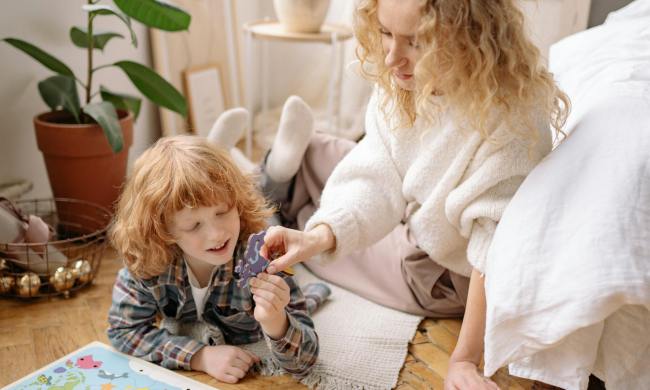Many have heard people talk about gentle parenting, but they don’t know exactly what it entails. Does it mean that kids run free-range without any discipline at all? Or is it parents and adults simply talking in a soothing voice at all times and letting them make all the choices, no matter what? Not exactly.
Gentle parenting can be interpreted differently by different families, but the general philosophy is to use respect and empathy to raise your child. It’s about modeling the golden rule by treating your child the way you want to be treated, so they learn to do the same for others. You use boundaries instead of punishments. No taking away dessert, no timeouts, and definitely no spanking.
Are you up for that lifestyle? How do kids learn what not to do if they don’t have consequences? Read more about gentle parenting below.
Does gentle parenting mean no discipline?

According to Sarah Ockwell-Smith, author of The Gentle Parenting Book and a dozen other parenting books, there are four pillars of gentle parenting:
- Empathy
- Respect
- Understanding
- Boundaries
She says, “Gentle parenting is not permissive parenting. Children do not always ‘get their own way,’ parents do not say ‘yes’ all of the time, scared of the upset if they say ‘no.’ In fact, often they can be more strict, with more boundaries in place than others.” She continues, “I am an incredibly ‘strict’ parent — in the sense that we have many family rules and lots of boundaries and limits that are consistently enforced. This last part is important. There is no point in having boundaries if you do not consistently enforce them. These limits give children a sense of security and they are vital.”
Gentle parenting takes a different approach to discipline. If you’re wondering if gentle discipline means no traditional punishments like timeouts, then the answer is yes. However, that doesn’t mean there are no boundaries and no teaching right and wrong. It’s a different way of trying to reach the same goal of getting children to understand things like hitting isn’t OK and they can’t throw their food, but it doesn’t involve punishment.
Janet Lansbury, author of Elevating Child Care: A Guide To Respectful Parenting and No Bad Kids: Toddler Discipline Without Shame, explains that the gentle discipline response if a child hit a dog would be “getting down on the floor next to the child, making eye contact, and saying calmly, ‘I won’t let you hit the dog, that hurts,’ while holding the child’s hand or otherwise blocking the hit.” Then you move on.
Is gentle parenting more effective?

Finding a parenting style that works for you is about the right fit for your family. What is more effective for one child or parent may not be more effective for another. Here are five things to consider before choosing gentle parenting for yourself:
- You have to have a lot of self-control to remain calm and patient in challenging situations.
- Modeling empathy, respect, and understanding can build a positive foundation for your child.
- Some argue there is a lack of needed consequences with gentle parenting.
- It may be difficult to introduce punishment later on (like with preteens) if you change your mind.
- Gentle parenting can build emotional intelligence and relationship skills.
It’s very difficult to say if one parenting style is “better” than another because research about styles differs based on different cultural, socioeconomic, and other factors, and they are hard to compare.
What’s wrong with gentle parenting?

Some parents struggle with how to implement parenting without punishment. Janet Lansbury explains that “setting limits without punishments works,” but that she hears from many parents that they run into lots of trouble, too. “There seems to be a common misconception that gentle, non-punitive discipline means avoiding a direct confrontation with the child rather than providing the simple, connected response children need,” she says. “My sense is that many parents overcomplicate this issue.”
Figuring out what to do at the moment can be one of the hardest parts of gentle parenting, as well as showing restraint when you really want to send them to their room not only because it was how you were raised, but because you also need a minute to calm down because you’re mad about what your child just did. The idea is that forming a strong, bonded relationship based on respect and empathy instead of a punitive one will benefit your child in the long run.
Gentle parenting will not be a fit for many parents, and finding the right fit for you is just a question of searching around. You also don’t need to find a strict philosophy or set of rules set out by someone else to live by. As long as you are consistent with whatever you do, just do what feels right to you.
What’s the opposite of gentle parenting?

The opposite of gentle parenting is authoritarian parenting, which is where the parents or guardians have full control and authority in the household. You may think this sounds reasonable, but those who practice authoritarian parenting tend not to exhibit much warmth toward their child, and don’t consider their child’s feelings, wants, or needs.
Children don’t typically respond well to authoritarian parents because there’s little consideration for their feelings. You may struggle with gentle parenting but that doesn’t mean you have to resort to authoritarian parenting. Find the right balance for yourself and your child and see what works for both of you.
What if gentle parenting doesn’t work?

Scroll through Instagram and you’ll read scripts for every situation, from leaving the park to hitting, written through the lens of a gentle parent. They sound great, always leading with respect and empathy. “You got really frustrated when your brother knocked over your toy trains. I would be mad, too. Hitting isn’t safe, though. I’m going to move over here with him so we can all be safe.”
“I know you really want to stay at the park. Leaving when we’re having so much fun is hard. We’re going to go home now, but I can’t wait to come back until tomorrow.”
Any parent can tell you it’s challenging to stay calm under pressure, such as when your kids are fighting or a child is having a very public meltdown. It can get even more challenging when your first attempt at these gentle statements doesn’t immediately solve the problem and give you back your happy kid.
Scripts can be helpful, but they can promote a cookie-cutter approach. Just because an influencer swears the statements work on a 19-month-old and you just need to be patient doesn’t mean that’s the case. You may need to reset and consider your child’s age and unique needs.
- Don’t confuse them. A younger toddler may not understand this: “Hmm. Two kids with one truck. I wonder what you’ll do about that.” They may need more guidance, such as, “She’s playing with the truck right now. When she’s done, you can have a turn. What can we do instead while we wait?”
- Be more concise. Teens don’t like long-winded lectures. Toddlers don’t understand them. Some scripts may not be the same length as your freshman-year biology lecture hall, but they can get a little lengthy. Try shorter requests like, “Shoes, please” instead of “Please go get your shoes so we can go to the store and then the park like I promised.” You’d be surprised how shaving off a few words can make a world of difference.
- Be patient. Patience is an important part of gentle parenting. Don’t put so much pressure on yourself or your child to be perfect. Gentle parenting is a process. Progress is the goal, and it’s not always linear. The endgame is an emotionally adjusted child who trusts you.
Does gentle parenting work?

It’s really not clear. There’s not a specific study on gentle parenting. We know from research that tactics from prior generations, like yelling and physical punishments, are harmful to children. Gentle parenting promotes secure attachment, trust, and respect — it might be worth a try in light of research pointing out what not to do. That said, you may snap and yell or send a child to a timeout — generational wounds die hard. Try not to beat yourself up.
You can sincerely apologize to your child — it sets a good example — and remember that every moment together is a chance to try again and do better.




